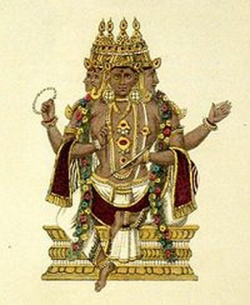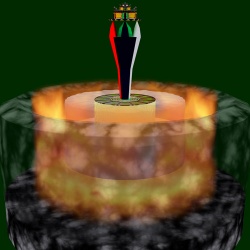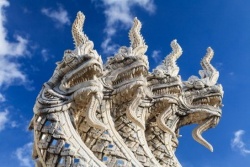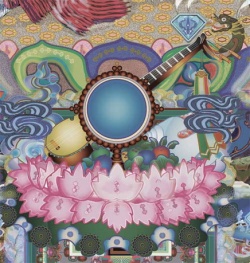Brahma Vihāra
The four Brahma Vihāras are considered by Buddhism to be the four highest emotions. The word brahma literally means ‘highest’ or ‘superior.’ It is also the name given to the supreme god in Brahmanism during The Buddha’s time. Vihāra means ‘dwelling,’ ‘living’ or ‘abiding.’
The brahmavihāras (sublime attitudes, lit. "abodes of brahma") are a series of four Buddhist virtues and the meditation practices made to cultivate them. They are also known as the four immeasurables (Sanskrit: apramāṇa, Pāli: appamaññā).
According to the Metta Sutta, Shākyamuni Buddha held that cultivation of the four immeasurables has the power to cause the practitioner to be reborn into a Brahma realm (Pāli: Brahmaloka). The meditator is instructed to radiate out to all beings in all directions the mental states of:
1) loving-kindness or benevolence
2) compassion
3) empathetic joy
4) equanimity
The four immeasurables are also found in Patañjali's Yoga Sutras (1.33), a text composed long after the beginning of Buddhism and substantially influenced by Buddhism. These virtues are also highly regarded by Buddhists as powerful antidotes to negative mental states (non-virtues) such as avarice, anger and pride.
Pāli: cattāri brahmavihārā
Sanskrit: 'चत्वारि ब्रह्मविहाराः (IAST: catvāri brahmavihārāḥ)
Brahmavihāra means “Brahma abidings”, or "sublime attitudes."[7] It may be parsed as "Brahma" and "vihāra"; which is often rendered into English as "sublime" or "divine abodes".
Apramāṇa, usually translated as "the immeasurables," means boundlessness, infinitude, a state that is illimitable. When developed to a high degree in meditation, these attitudes are said to make the mind "immeasurable" and like the mind of the loving brahmā (gods).
Other translations:
English: four divine abodes, four divine emotions, four sublime attitudes.
East Asia: 四無量心 (pinyin: Sì wúliàng xīn; Japanese: Shi muryō shin; Korean: 사무량심 Sa mulyang sim; Vietnamese: Tứ Vô Lượng Tâm; literally: "immeasurable states of mind, from apramāṇa-citta"), 四等(心) (pinyin: sì děng; literally: "four equalities/universals"), 四梵行 (pinyin: sì Fàn xíng; literally: "noble Brahma-acts/characteristics").
Tibetan: ཚད་མེད་བཞི, Wylie: tshad med bzhi or Tibetan: ཚངས་གནས་བཞི་, Wylie: tshangs gnas bzhi.
Exegesis
The four immeasurables are:
Loving-kindness (Pāli: mettā, Sanskrit: maitrī) towards all: the hope that a person will be well; "the wish that all sentient beings, without any exception, be happy."
Compassion (Pāli and Sanskrit: karuṇā): the hope that a person's sufferings will diminish; "the wish for all sentient beings to be free from suffering."
Empathetic joy (Pāli and Sanskrit: mudita): joy in the accomplishments of a person—oneself or another; sympathetic joy; "the wholesome attitude of rejoicing in the happiness and virtues of all sentient beings."
Equanimity (Pāli: upekkhā, Sanskrit: upekṣā): learning to accept loss and gain, good-repute and ill-repute, praise and censure, sorrow and happiness (Attha Loka Dhamma), all with detachment, equally, for oneself and for others. Equanimity is "not to distinguish between friend, enemy or stranger, but regard every sentient being as equal. It is a clear-minded tranquil state of mind—not being overpowered by delusions, mental dullness or agitation."
Loving-kindness and compassion can both be viewed as hopes for the future leading, where possible, to action aimed at realizing those hopes. Joy and equanimity can be seen as attitudes useful for reflecting on what has already past and, through this reflection, present us with an opportunity to apply knowledge to our actions. Consequently while the four immeasurables might be delineated as attitudes to the future or past, they contain the seed of the "present" within their core; as they manifest new ways to act (a living embodied practice). In this context, a living bodied practice can be a dedicated intention that we are in the "here and now"; that is to say we experience both a tranquil awareness of at once a) our own and other being's gifts and accomplishments and b) tranquil awareness of moments where our own and other being's actions do not reflect the four immeasurables.
"All we experience is preceded by mind,
Led by mind, made by mind. Speak or act with a corrupted mind
And suffering follows
As the wagon wheel follows the hoof of the ox.
All we experience is preceded by mind,
Led by mind, made by mind.
Speak or act with a peaceful mind
And happiness follows Like a shadow that never leaves." - Dhammapada 1-2
Central to Buddhist spiritual practice is a deep appreciation of the present moment and the possibilities that exist in the present for waking up and being free of suffering.[15] The four immeasurables can represent a way of experiencing the past and the future in an enlightened manner, a manner that avoids suffering and encourages peace and happiness.
Brahmavihāra practice in the Visuddhimagga
The four immeasurables are explained in The Path of Purification (Visuddhimagga), written in the fifth century CE by the scholar and commentator Buddhaghoṣa. They are often practiced by taking each of the immeasurables in turn and applying it to oneself, and then to others nearby, and so on to everybody in the world, and to everybody in all universes.
Legacy
Although this form of these ideas has a Buddhist origin, the ideas themselves are in no way sectarian. The Sarvodaya Shramadana Movement uses them in public meditation events in Sri Lanka bringing together Buddhists, Hindus, Muslims, and Christians. Rudyard Kipling's inspirational poem If refers to the idea of upekkhā in calling Triumph and Disaster impostors.
The four immeasurables in early Buddhism
In the Tevijja Sutta: The Threefold Knowledge of the Majjhima Nikaya set of scriptures, Buddha Shākyamuni is asked the way to fellowship/companionship/communion with Brahma. He replies that he personally knows the world of Brahma and the way to it, and explains the meditative method for reaching it by using an analogy of the resonance of the conch shell of the aṣṭamaṅgala:
A monk suffuses the world in the four directions with a mind of benevolence, then above, and below, and all around – the whole world from all sides, completely, with a benevolent, all-embracing, great, boundless, peaceful and friendly mind … Just as a powerful conch-blower makes himself heard with no great effort in all four [cardinal] directions, so too is there no limit to the unfolding of [this] heart-liberating benevolence. This is a way to communion with Brahma.[
The Buddha then says that the monk must follow this up with an equal suffusion of the entire world with mental projections of compassion, sympathetic joy, and equanimity (regarding all beings with an eye of equality).
In the two Metta Suttas of the Aṅguttara Nikāya, the Buddha states that those who practice radiating the four immeasurables in this life and die "without losing it" are destined for rebirth in a heavenly realm in their next life. In addition, if such a person is a Buddhist disciple (Pāli: sāvaka) and thus realizes the three characteristics of the five aggregates, then after his heavenly life, this disciple will reach nibbāna. Even if one is not a disciple, one will still attain the heavenly life, after which, however depending on what his past deeds may have been, one may be reborn in a hell realm, or as an animal or hungry ghost.
Presence of comparable practice in Jainism
In an authoritative Jain scripture, the Tattvartha Sutra (Chapter 7, sutra 11), there is a mention of four right sentiments: Maitri, pramoda, karunya, madhyastha.
A Cavern of Treasures (mDzod-phug)
A Cavern of Treasures (Tibetan: མཛོད་ཕུག, Wylie: mdzod phug) is a Bonpo terma uncovered by Shenchen Luga (Tibetan: གཤེན་ཆེན་ཀླུ་དགའ, Wylie: gshen-chen klu-dga') in the early eleventh century. A segment of it enshrines a Bonpo evocation of the four immeasurables.[19] Martin (n.d.: p. 21) identifies the importance of this scripture for studies of the Zhang-Zhung language.
Thus the Brahma Vihāras are not emotions one occasionally feels, but those that one ‘lives in’ and ‘lives by’ all the time. These four Brahma Vihāras are love, compassion, sympathetic joy and equanimity. They can be understood from several different perspectives – as four related but separate qualities or perhaps better, as four different ways by which the spiritually mature person relates to others according to their situation.
So, for example, we relate to friendly people with love, to those in distress with compassion, to the successful with sympathetic joy and to unpleasant people with equanimity. The purpose of the practice called Loving-kindness meditation is to encourage and nurture the Brahma Vihāras.
The four "sublime" or "divine" abodes that are attained through the development of boundless metta (goodwill), karuna (compassion), mudita (appreciative joy), and upekkha (equanimity).
Four "sublime abidings" (lit. abodes of Brahma) that accompany spiritual development, consisting of compassion, loving kindness, sympathetic joy for others, and equanimity toward the pleasant and the unpleasant.
The four sublime states: loving kindness, compassion, sympathetic joy and evenness of mine.
Brahma Vihara (Pali, Sanskrit) Heavenly or sublime abode, the four mind states said to lead to a rebirth in a heavenly realm: lovingkindness (metta), compassion (karuna), appreciative joy (mudita) and equanimity (upekkha)
The four Brahmaviharas are a series of virtues and Buddhist meditation practices designed to cultivate those virtues. Brahmavihara is a term in Pali and Sanskrit meaning "Brahma abidings", or "Sublime attitudes." They are also known as the Four Immeasurables (Sanskrit: apramana).
According to the Metta Sutta, Shakyamuni Buddha held that cultivation of the Brahmaviharas has the power to cause the practitioner to be re born into a Brahma realm (Pali: Brahmaloka). The meditator is instructed to radiate out to all beings in all directions the mental states of:
loving kindness or benevolence,
compassion,
sympathetic joy, and,
equanimity.
These virtues are also highly regarded by Buddhists as powerful antidotes to those negative mental states (non virtues) like avarice, anger, pride and so on.
See Kindness and Sympathy.
The Four Sublime States, Nyanaponika,1980.






